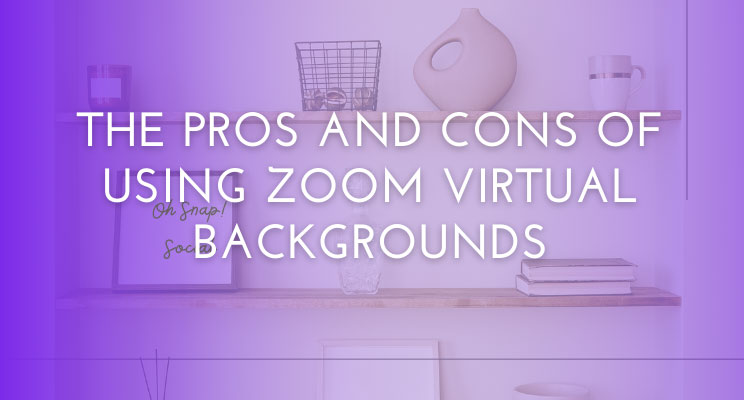Since 2020, basically all of my meetings have been done through Zoom. I won’t lie: as a curious person, it’s been a fascinating way to visit other people’s homes. But obviously, you don’t always want the world being able to peek into your office, especially if that office is your bedroom or kitchen or you have kiddos running around behind you. That’s where Zoom virtual backgrounds come in. This handy-dandy feature overlays a digital environment over your real one, allowing you to Zoom from the offices of Waystar Royco, outer space, or whatever floats your boat (you can Zoom from a boat, too!) But just like deciding whether to switch your FB account to Professional Mode, Zoom virtual backgrounds have their pros and cons.
The pros of Zoom virtual backgrounds
If you’ve jumped on a call with me, you know that I think there are tons of reasons to love Zoom backgrounds. You can:
- Maintain your privacy. We have to give a ton of ourselves to the internet and our work already. Let’s face it – being authentic comes at a cost. If you’re not cool with showing the world or your clients where and how you live, a virtual background can be a good way to draw a line between what you’re willing to share and what you want to keep for yourself.
- Get creative! There’s tons you can do with a Zoom virtual background. Zoom from the beach during a casual post-work get-together. Pick a background that reflects the tone or mood of your presentation – maybe it’s space, or the Simpsons. Or use Canva to outfit your Zoom space with your products, brand colors and intriguing calls-to-actions. Shoot! I’ve seen some professionals utilize QR codes on their virtual backgrounds as well. Zoom backgrounds can be a great way to showcase your personal brand, or just to add some extra levity to your meeting or presentation!
- Get aspirational. First impressions matter. If you don’t live in a mega-mansion or fancy brownstone, fake it with a Zoom background that helps you walk the walk. Maybe it’s a faux boardroom, or perhaps a super-fancy home office appointed exclusively in this season’s Crate & Barrel. As they say, dress for the job you want, not for the one you have!
- Hide that mess! Share a home with kids or pets? Your space might not be fit for public consumption. Slap on a Zoom background, and bam – that unmade bed and the crayon on the wall never happened. Just remember that a Zoom background can’t mute kids or pets – and that it won’t hide their faces if they decide to jump on the call! (Feeling frazzled? Try these quick tips for looking camera ready in minutes.)
The cons of Zoom virtual backgrounds
Zoom virtual backgrounds have saved me from myself a bunch of times, but nothing’s perfect. Some of the cons of Zoom backgrounds are:
- They’re not real. Stating the obvious here, but the fact that Zoom backgrounds are fake can be a con. In a world where authenticity is a big selling point, opting for a fake background may be a no-no for your brand. Whether this is a con in your case in particular totally depends on who you are, what your brand is all about, and what kind of background you choose. Promoting your new ebook and opting for a background with your cover on it? All good. Selling courses on how to make millions in business and choosing a background of a fake corner office? Yeah, you might get called out.
- They can glitch and lag. Virtual backgrounds aren’t perfect, and you might see glitching as you move around on the screen – or if you’re a hand talker like me. Lag can also be an issue on slow connection or if you haven’t updated your software recently. And as much as we hate that this is a thing, people with darker skin may also find that the tech is less than perfect for them. Let’s face it: in spite of your best efforts, tech is gonna tech.
- They work best in certain environments. Zoom backgrounds work best in well lit, simple spaces with solid-color backgrounds. For best results, use a pop-up or standing green screen (tip: don’t wear green if you do this!!) If you’re not sure how well your background will work, do a trial run before a big meeting or presentation. That way you can figure out your light sources and any connectivity issues – and make sure that you don’t disappear into your background!
My advice? Go with what works for your brand, the meeting in question – and your life. Sometimes a virtual background makes sense; sometimes it’s better to go au naturale. If you’re showing up to a job interview, aim for authentic. If the meeting is a casual social meet-up with clients, a fun background can be a great ice-breaker.
What’s your take? Are you team virtual, or team real life? Drop me a note on Instagram to let me know where you stand!

